\(f\sigma_8\) as a probe for general relativity
Cosmological principle:
Universe is homogeneous
Observations:
Universe is not exactly homogeneous
Matter density fluctuations: $\delta(\mathbf{x}) = \frac{\rho(\mathbf{x})}{\bar{\rho}} - 1$
$\sigma_8$ : fluctuation over sphere of
8 Mpc.$h^{-1}$ radius
$\delta(\mathbf{x}) = \sigma_8 \tilde{\delta}(\mathbf{x})$
Fluctuations evolve over time
$\delta(\mathbf{x}, t) = \delta(\mathbf{x})D(t)$
Evolution of structures:
Dark energy vs Gravity
$$f = \frac{\text{d}\ln D}{\text{d}\ln a}$$
$f \simeq \Omega_m^\gamma$
General Relativity + $\Lambda$CDM: $\gamma \simeq 0.55$
$\gamma \equiv$ Growth index
$f$ measurement is generally degenerate with $\sigma_8$ !
$\Rightarrow f\sigma_8$

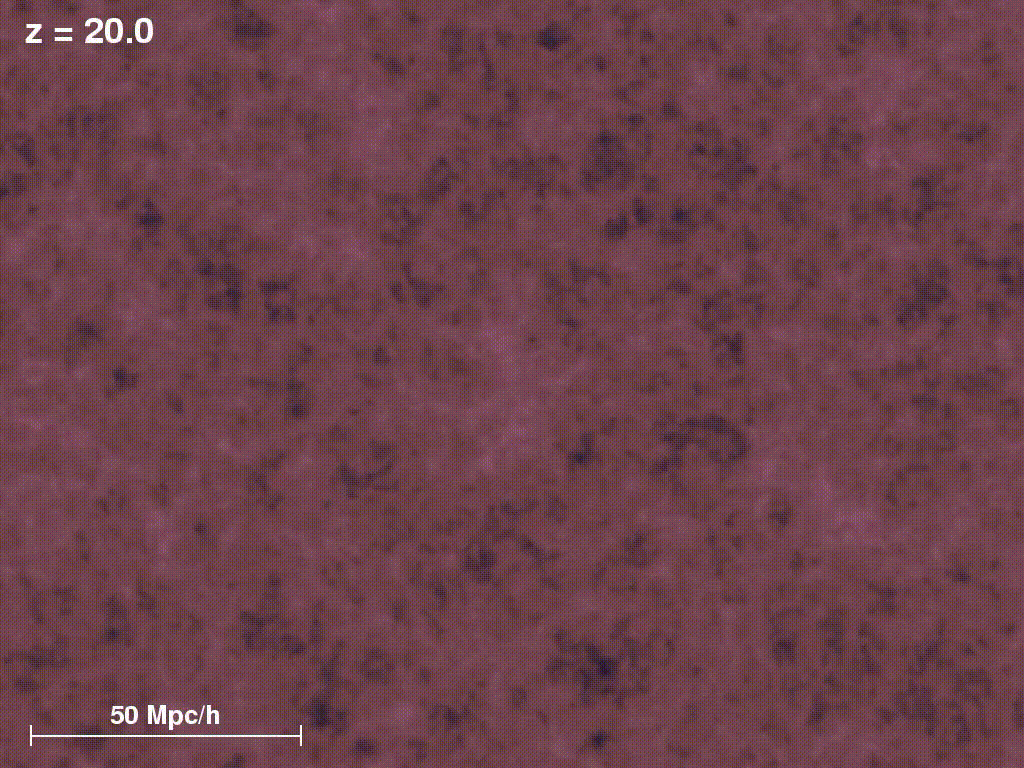
Image credits: Illustris TNG
How to measure $f\sigma_8$ ?
Velocities are probes of $f\sigma_8$!
Velocity statistics directly depend on $f\sigma_8$:
$\langle v(\mathbf{x_i})v(\mathbf{x_j})\rangle \propto \left(f\sigma_8\right)^2$
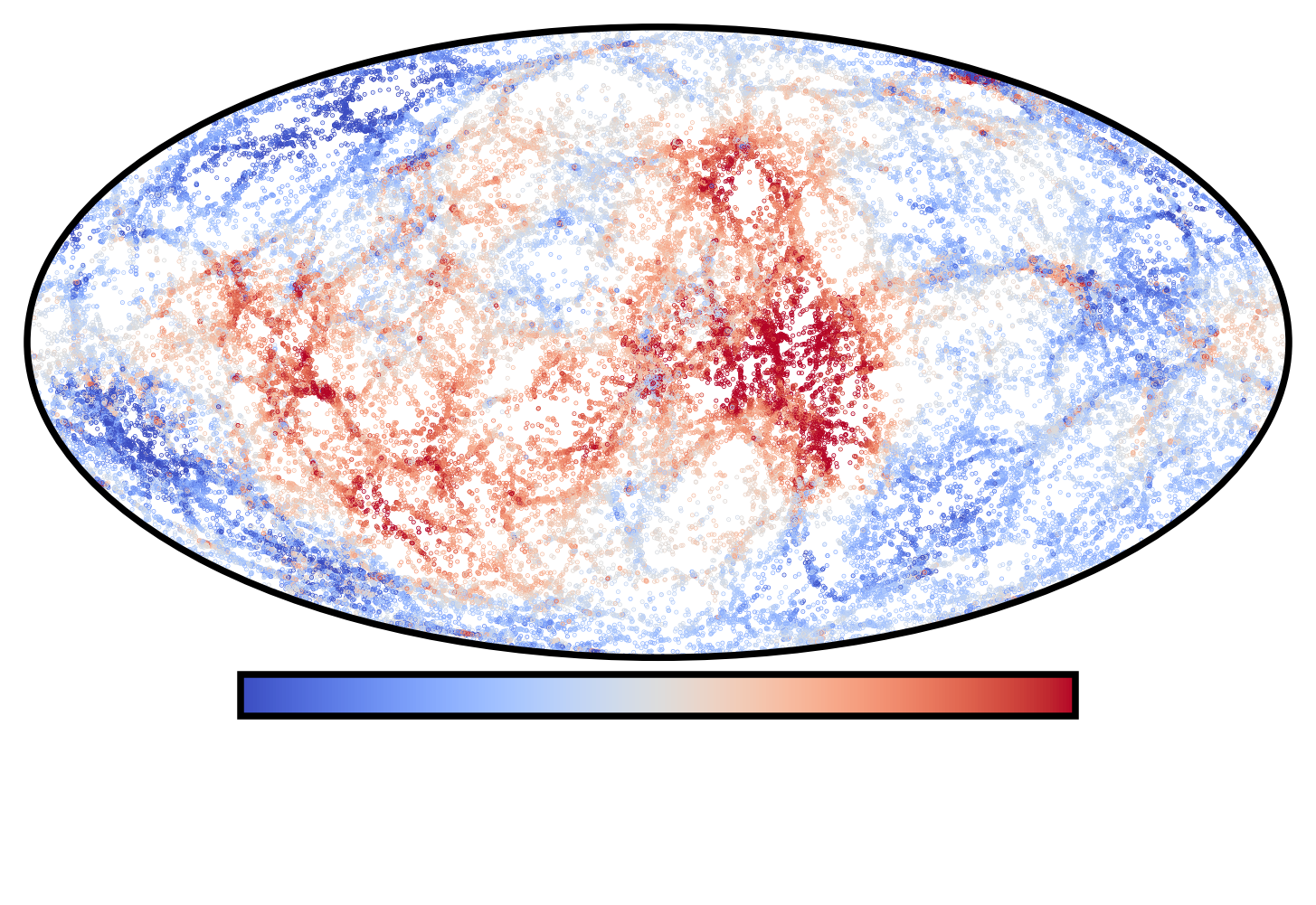
Image credits: Illustris TNG
Estimating velocities from SNe Ia
Observed redshifts:
$1 + z_\mathrm{obs} = (1 + z_\mathrm{cos}) (1 + z_\mathrm{p})$ with $z_p\simeq v_p / c$
Hubble residuals:
$\Delta\mu = \mu_\mathrm{obs} - \mu_\text{th}(z_\mathrm{obs}) = 0$
$\Delta\mu = \mu_\mathrm{obs} - \mu_\text{th}(z_\mathrm{obs}) \simeq-\frac{5}{c\ln10}\left(\frac{(1 + z)c}{H(z)r(z)} -
1\right)v_p$
$v_p \simeq -\frac{c\ln10}{5}\left(\frac{(1 + z)c}{H(z)r(z)} - 1\right)^{-1}\Delta\mu$ $\sigma_{v_p} \simeq -\frac{c\ln10}{5}\left(\frac{(1 + z)c}{H(z)r(z)} - 1\right)^{-1}\sigma_{\Delta\mu}$
The intrinsic scatter of SNe Ia
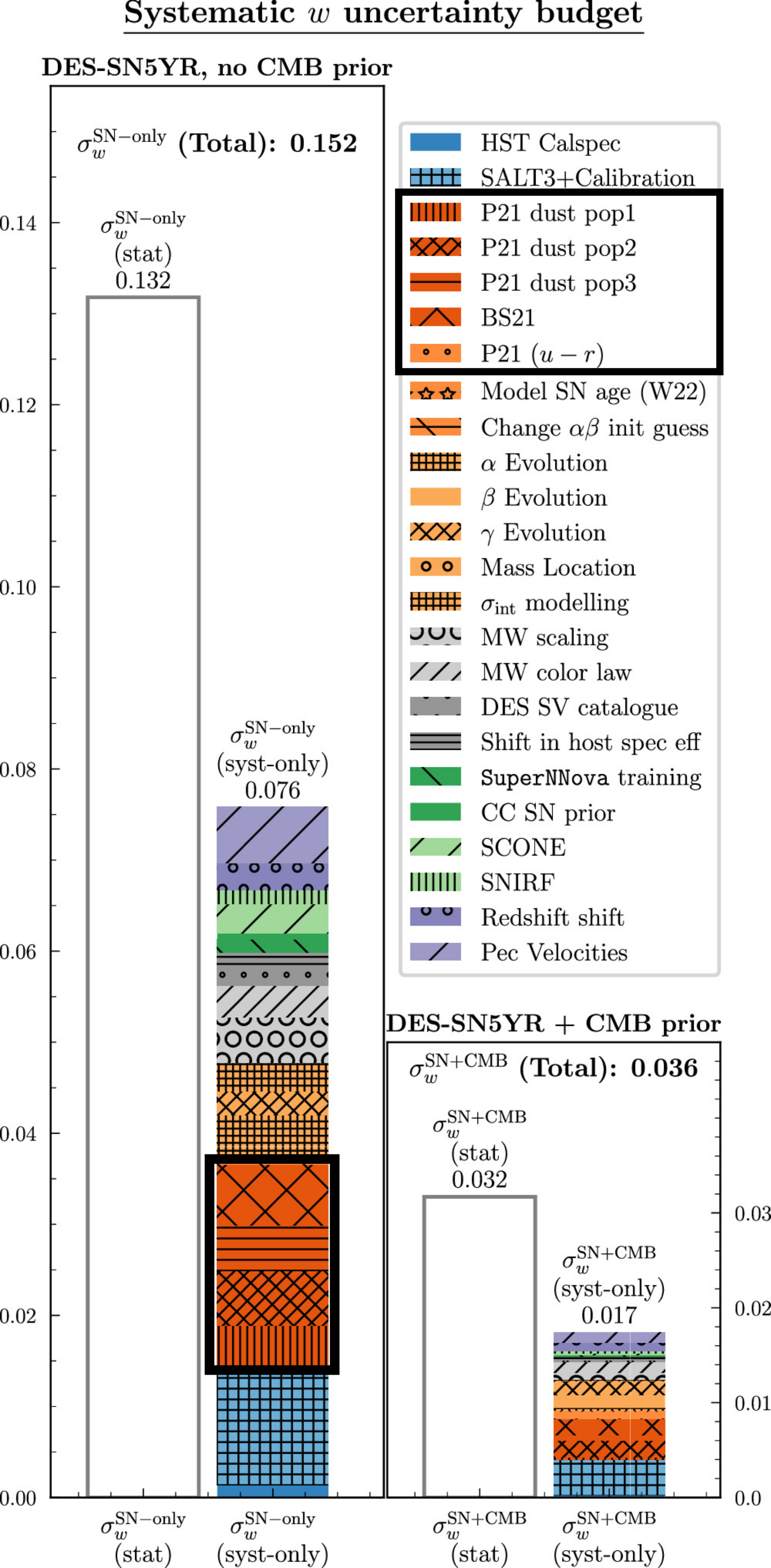
Main systematic of DES 5-year dark energy analysis (Vincenzi et al. 2023)!!!
What about $f\sigma_8$ ???
The intrinsic scatter of SNe Ia
In this work we considered 4 models of intrinsic scatter
-
Random coherent scatter (COH)
Achromatic
Unrealistic
-
The G10 model (Guy et al. 2010):
$\sim 70\%$ achromatic / $\sim 30\%$ chromatic
Historically used (Pantheon, Pantheon+)
-
The C11 model (Chotard et al. 2011):
$\sim 30\%$ achromatic / $\sim 70\%$ chromatic
Historically used (Pantheon, Pantheon+)
-
The BS21 model (Brout & Scolnic 2021),
parameters from Popovic et al. 2023 (P23):
Dust-based model
Currently favored by data (DES 5-year)
Achromatic
Unrealistic
$\sim 70\%$ achromatic / $\sim 30\%$ chromatic
Historically used (Pantheon, Pantheon+)
$\sim 30\%$ achromatic / $\sim 70\%$ chromatic
Historically used (Pantheon, Pantheon+)
parameters from Popovic et al. 2023 (P23):
Dust-based model
Currently favored by data (DES 5-year)
Rubin-LSST Simulations
We used the SNANA software (Kessler et al. 2009) to simulate the 10 years of the Rubin-LSST survey!
- Survey parameters from LSST survey simulation (OpSim)
-
SN Ia model: Spectra model (SALT3) + SALT parameter distributions + intrinsic scatter model
-
Host catalog: Uchuu UniverseMachine N-body simulation (Ishiyama et al. 2021, Aung et al. 2022)
Simulation: Correlations SN Ia - host

Simulation: the SNe Ia simulated sample
Simulation up to $z\sim0.16 \ \Rightarrow \ N_\text{SN} \sim O(50 \ 000)$
Using SNe Ia up to $z\sim0.1 \ \Rightarrow \ N_\text{SN} \sim O(6~600)$
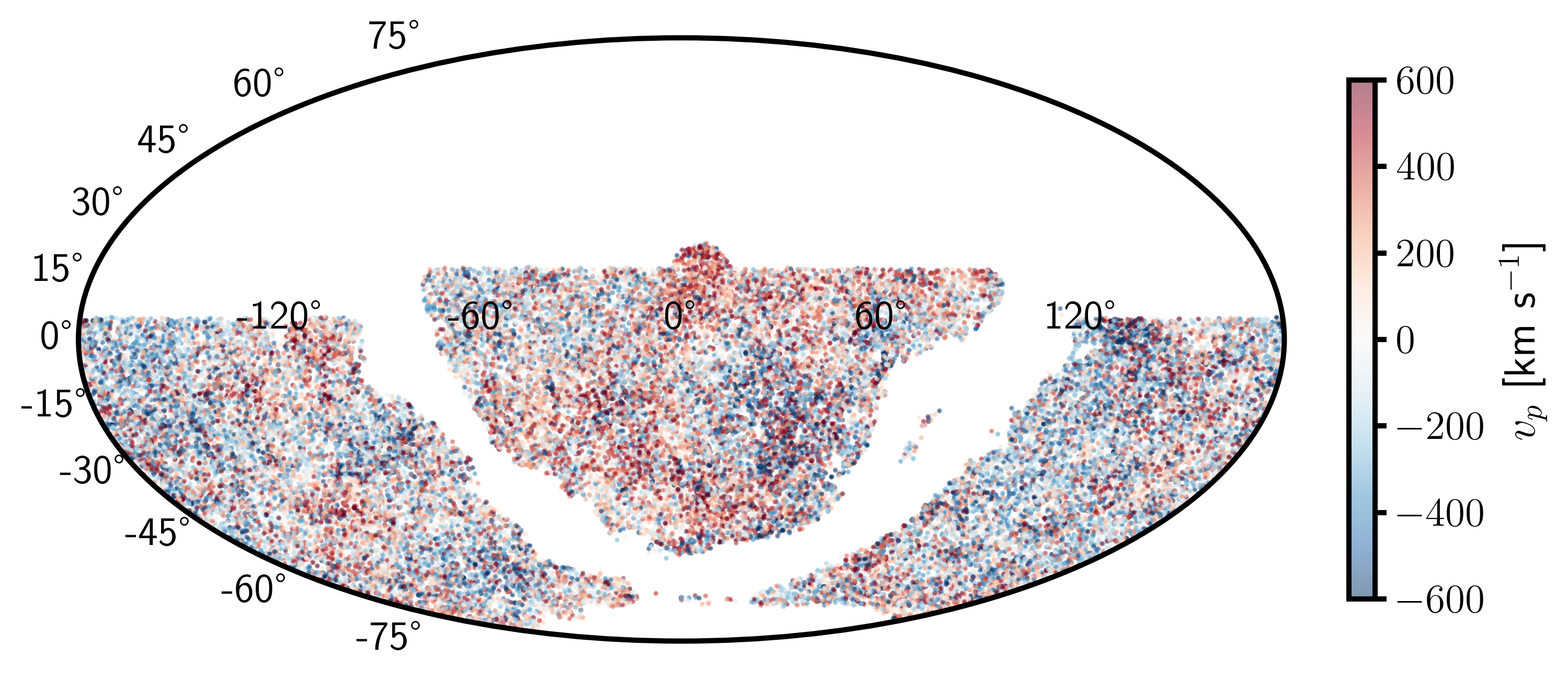
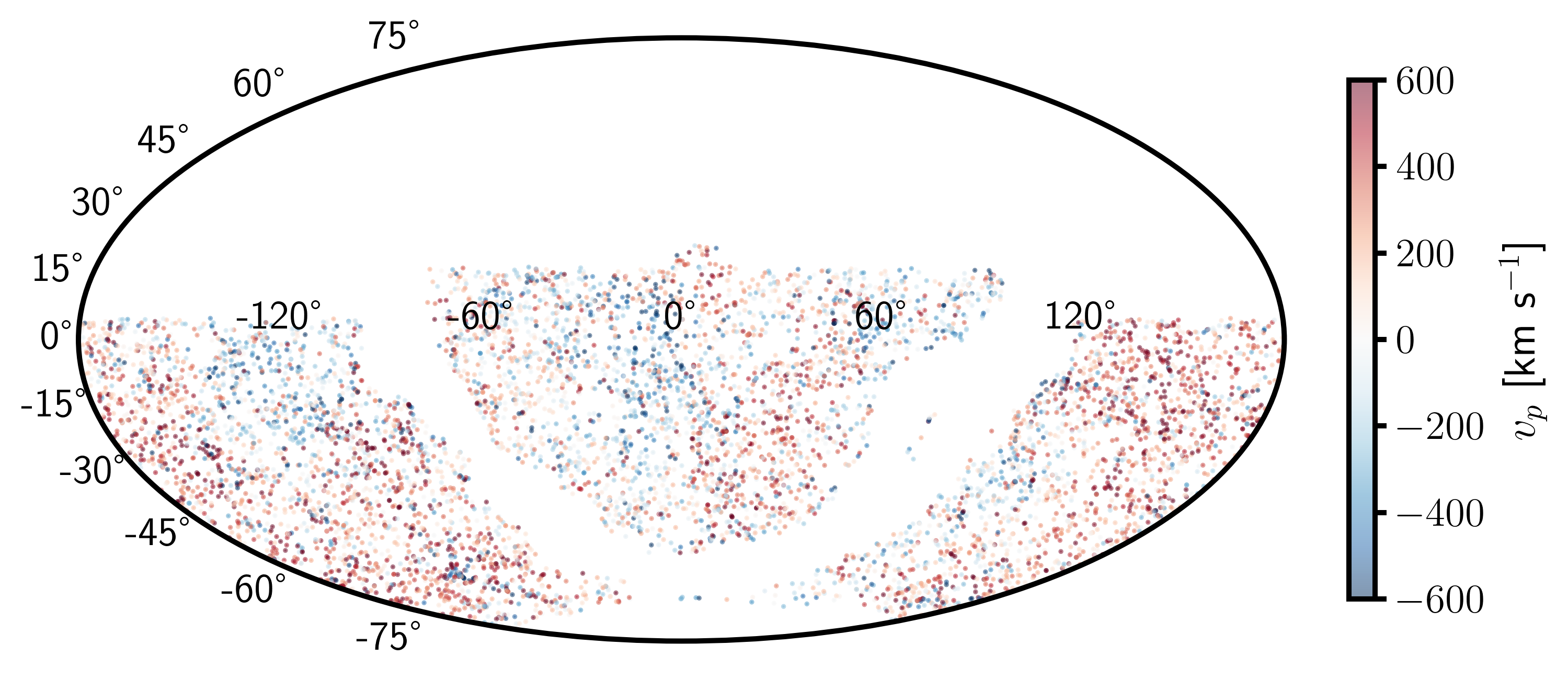
Building the Hubble diagram
Building the Hubble diagram: simple framework
Fit for the Tripp relation along $f\sigma_8$:
$\boldsymbol{\mu_\mathrm{obs}} = \boldsymbol{m_B} - \left({\color{red} M_0} - {\color{red} \alpha} \boldsymbol{x_1} + {\color{red}
\beta} \boldsymbol{c} + \boldsymbol{\Delta_M}\left(\mathbf{M_\mathrm{host}}; {\color{red} \gamma}\right)\right)$
$\boldsymbol{\sigma_\mu}^2 = \boldsymbol{\sigma_\mathrm{obs}}^2 + {\color{red}\sigma_\mathrm{int}}^2$
${\color{red}M_0}$, ${\color{red}\alpha}$, ${\color{red}\beta}$, ${\color{red}\gamma}$ and ${\color{red}\sigma_\mathrm{int}}$ are free
parameters.
Building the Hubble diagram
Building the Hubble diagram: BBC framework
$\boldsymbol{\mu_\mathrm{obs, BBC}} = \boldsymbol{m_B} - \left({\color{red} M_0} - {\color{red}\alpha} \boldsymbol{x_1} +
{\color{red}\beta} \boldsymbol{c} + \boldsymbol{\Delta_M}\left(\mathbf{M_\mathrm{host}}; {\color{red}\gamma}\right)\right) +
\delta_\mathrm{corr.}$
$\boldsymbol{\sigma_\mu}^2 = \boldsymbol{\sigma_\mathrm{obs}}^2 + {\color{red}\sigma_\mathrm{int}}^2$
$\delta_\mathrm{corr.}$ is obtained by:
-
Running an extra-large simulation ($\sim40\times$ LSST) and fitting the Hubble diagram
-
Binning over the parameters $p=\left\{z_\mathrm{obs}, x_1, c, M_\mathrm{host}\right\}$
-
Computing the correction in each cell $\delta_\mathrm{corr.} = \left<\mu_\mathrm{obs} - \mu_\mathrm{fid}\right>_\mathrm{cell}$
- Interpolate over the cells to obtain $\delta_\text{corr.}(p)$
${\color{red}\alpha}$, ${\color{red}\beta}$, ${\color{red}\gamma}$ and ${\color{red}\sigma_\mathrm{int}}$ are fitted prior to
$f\sigma_8$
The maximum likelihood method
The maximum likelihood mehod
The Maximum likelihood method is implemented within the
![]() package (Ravoux, Carreres et al. 2025)
package (Ravoux, Carreres et al. 2025)
We want to maximize the likelihood function: $$\mathcal{L}(f\sigma_8; v_p) \propto \left(2\pi\right)^{-\frac{N}{2}}\left|\text{C}(f\sigma_8)\right|^{-\frac{1}{2}}\exp\left(-\frac{1}{2}\boldsymbol{v_p}^T\text{C}(f\sigma_8)^{-1}\boldsymbol{v_p}\right)$$
$\text{C}(f\sigma_8) =\text{C}^\mathrm{obs} + \text{C}^{vv}(f\sigma_8)$
The maximum likelihood mehod: velocity covariance
The covariance of the velocity field is: $$\langle v_i(\mathbf{r}_i) v_j(\mathbf{r}_j)\rangle = \text{C}_{ij}^{vv}\propto
({\color{red}f\sigma_8})^2 \int_{k_\mathrm{min}}^{k_\mathrm{max}} P(k) W_{ij}(k; \mathbf{r}_i, \mathbf{r}_j) {\rm d}k $$
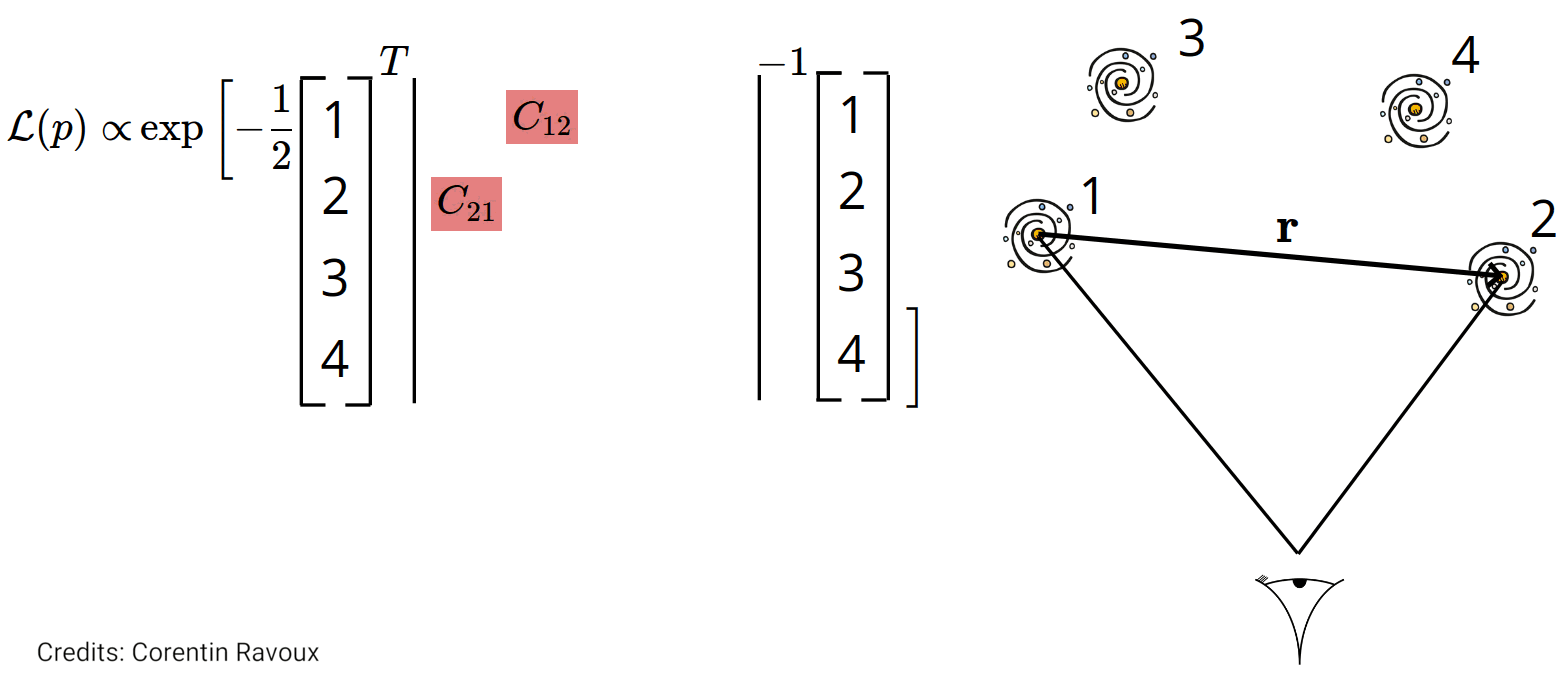
The $\sigma_u$ redshift space parameter
Positions are evaluated using $z_\mathrm{obs} \ \Rightarrow$ Redshift Space Distorsion
Empirical damping introduced in Koda et al. 2014: $D_u = \text{sinc}(k\sigma_u)$
$$\text{C}_{ij}^{vv}\propto (f\sigma_8)^2 \int_{k_\mathrm{min}}^{k_\mathrm{max}} P(k){\color{red} D_u(k, \sigma_u)}^2 W_{ij}(k;
\mathbf{r}_i, \mathbf{r}_j) {\rm d}k$$
From a fit of true vel. from randomly sampled galaxies of the Uchuu simulation we found $\sigma_u \simeq 21 \text{ Mpc }h^{-1}$
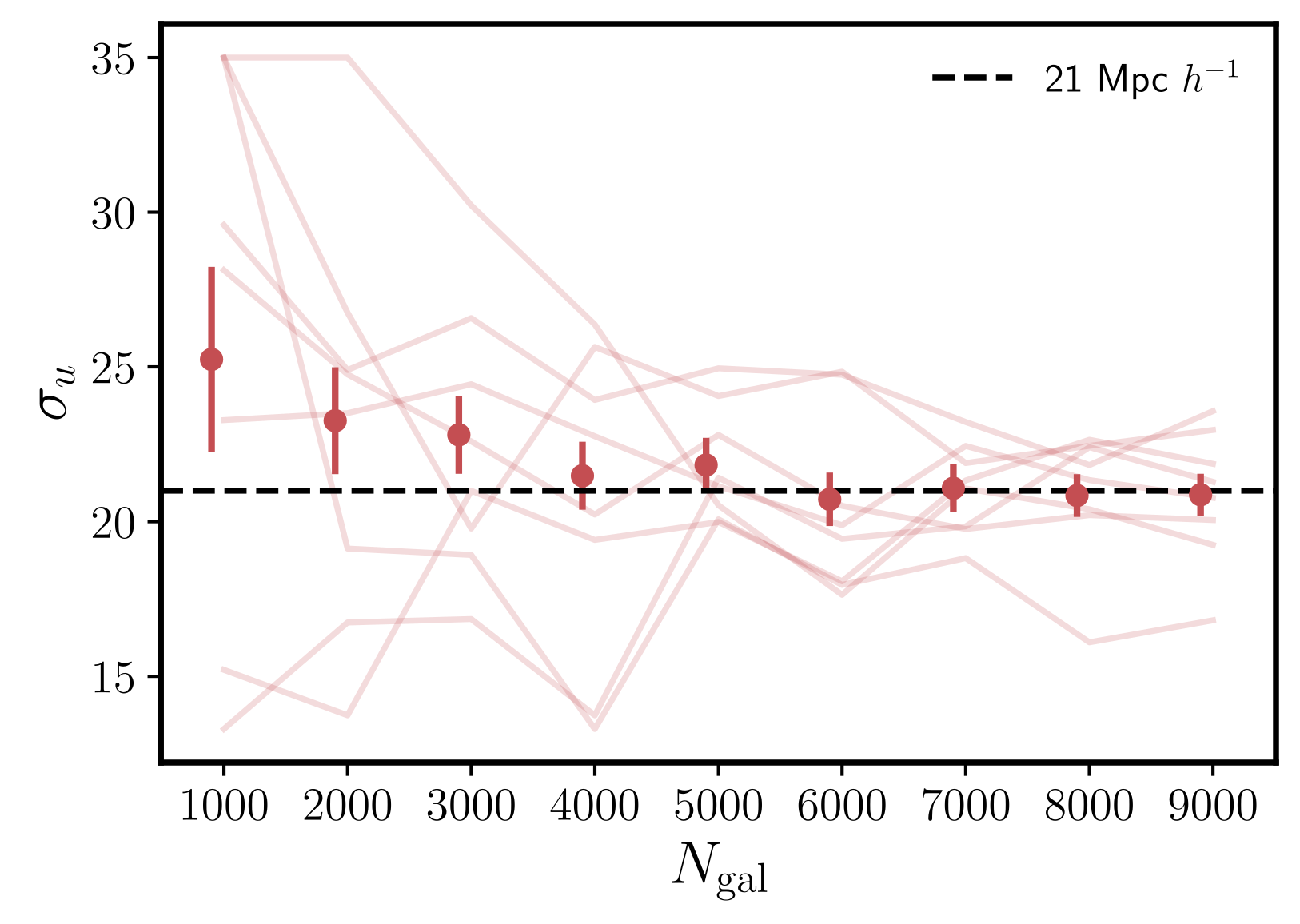
Fitting for $f\sigma_8$
Results: Estimated velocities
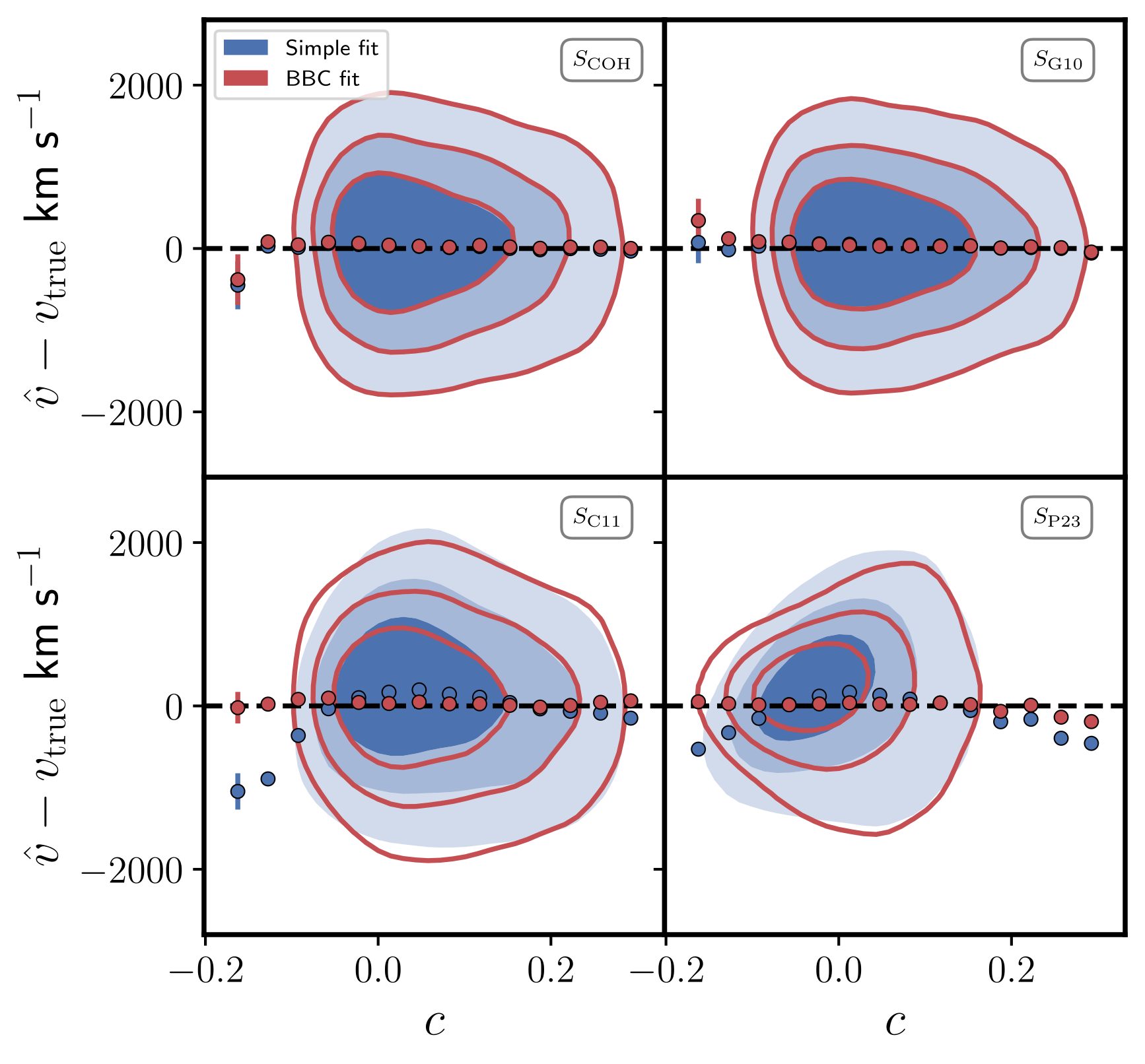
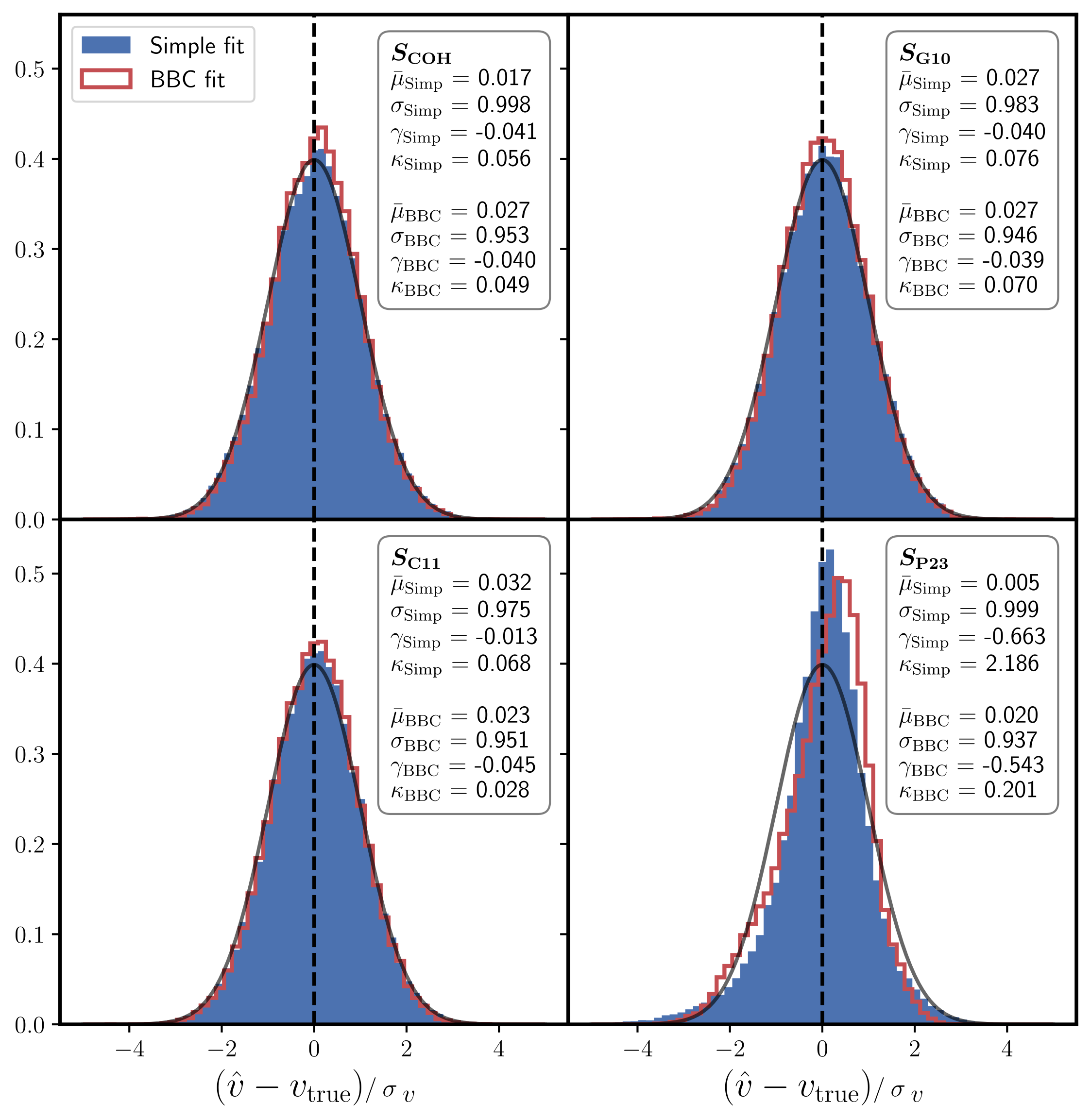
Results: $f\sigma_8$ fit for different scatter models
-
True vel. fit:
Unbiased $f\sigma_8$
$\sigma_{f\sigma_8}\sim 5\%$
-
COH, G10 and C11:
Similar results for simple and BBC fit
Unbiased $f\sigma_8$
$\sigma_{f\sigma_8}\sim 13-14\%$
-
P23 - Simple fit: $\sigma_{f\sigma_8}\sim 15\%$
P23 - BBC fit: $\sigma_{f\sigma_8}\sim11\%$
Results for P23 are biased by $>20\%$ !!!
Unbiased $f\sigma_8$
$\sigma_{f\sigma_8}\sim 5\%$
Similar results for simple and BBC fit
Unbiased $f\sigma_8$
$\sigma_{f\sigma_8}\sim 13-14\%$
P23 - BBC fit: $\sigma_{f\sigma_8}\sim11\%$
Results for P23 are biased by $>20\%$ !!!
Results: Systematics - BS21 parameter variations
Errors on BS21 parameters propagated as in DES 5-year analysis (Vincenzi et al. 2024)
No change in $f\sigma_8$ fit!!!

Results: Systematics - $\sigma_u$ RSD parameter
$\Delta\sigma_u \sim 18.5 - 23.5 \text{ Mpc }h^{-1}$ ⇨ $\sigma_{f\sigma_8}^{\sigma_u}\sim6\%$
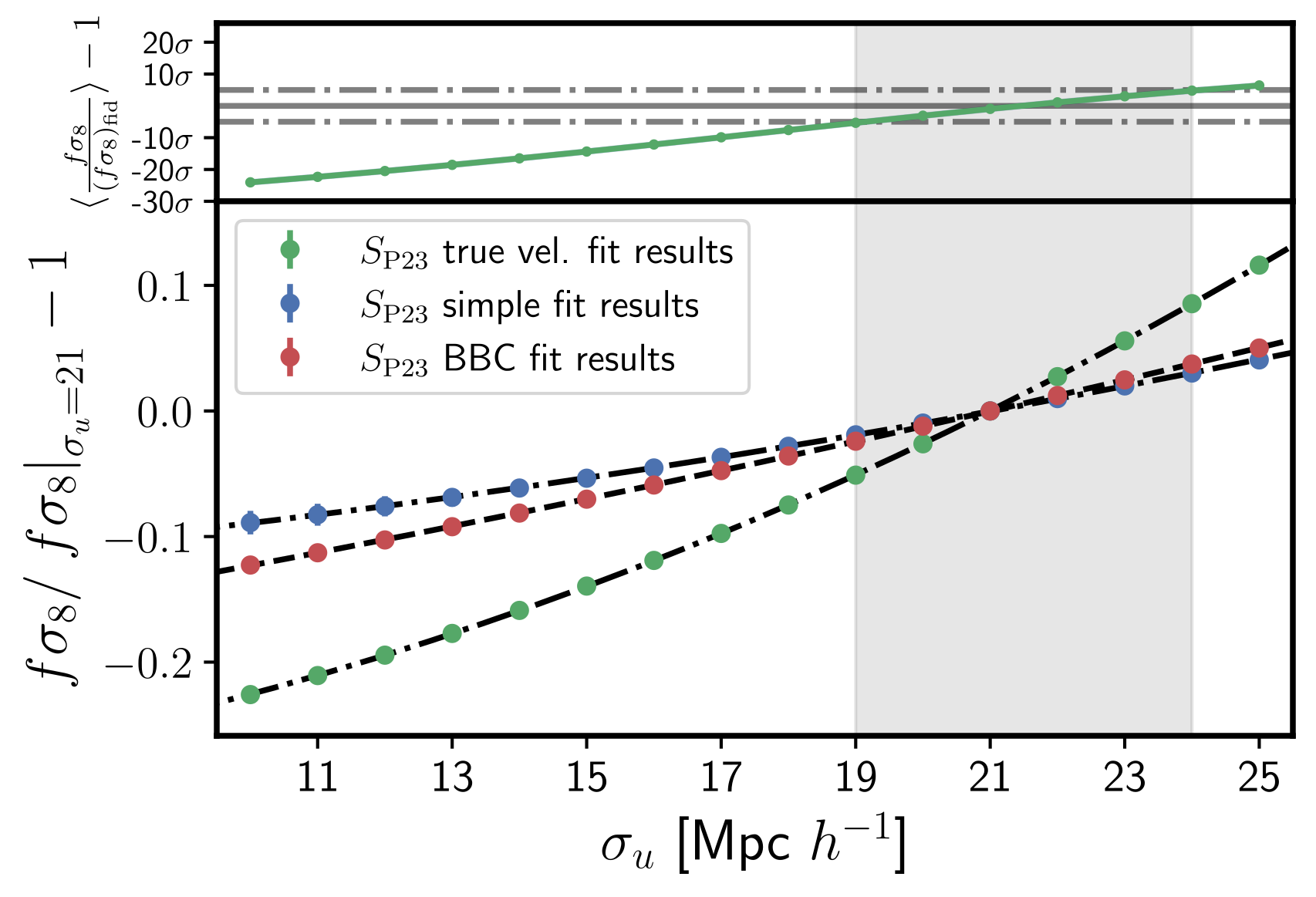
Conclusion
-
Estimated PVs are on average unbiased when using the BBC method compared to the simple method
- The BS21 model predicts non-gaussianity that biases the measurement of $f\sigma_8$
- Statistical error represents $75\%$ of the $f\sigma_8$ error budget
- The uncertainty on BS21 parameters is not a major systematic for $f\sigma_8$
-
The leading systematic, the uncertainty on the RSD parameter, $\sigma_u$, leads to an error of $\sim6\%$ on $f\sigma_8$
What's next?
- Is the BS21 model prediction correct? Will we see non-Gausianities in data?
- Is it possible to find a better RSD parametrisation than $\sigma_u$?
Thank you for your attention !
Full $f\sigma_8$ results

$\sigma_u$ syst. for G10
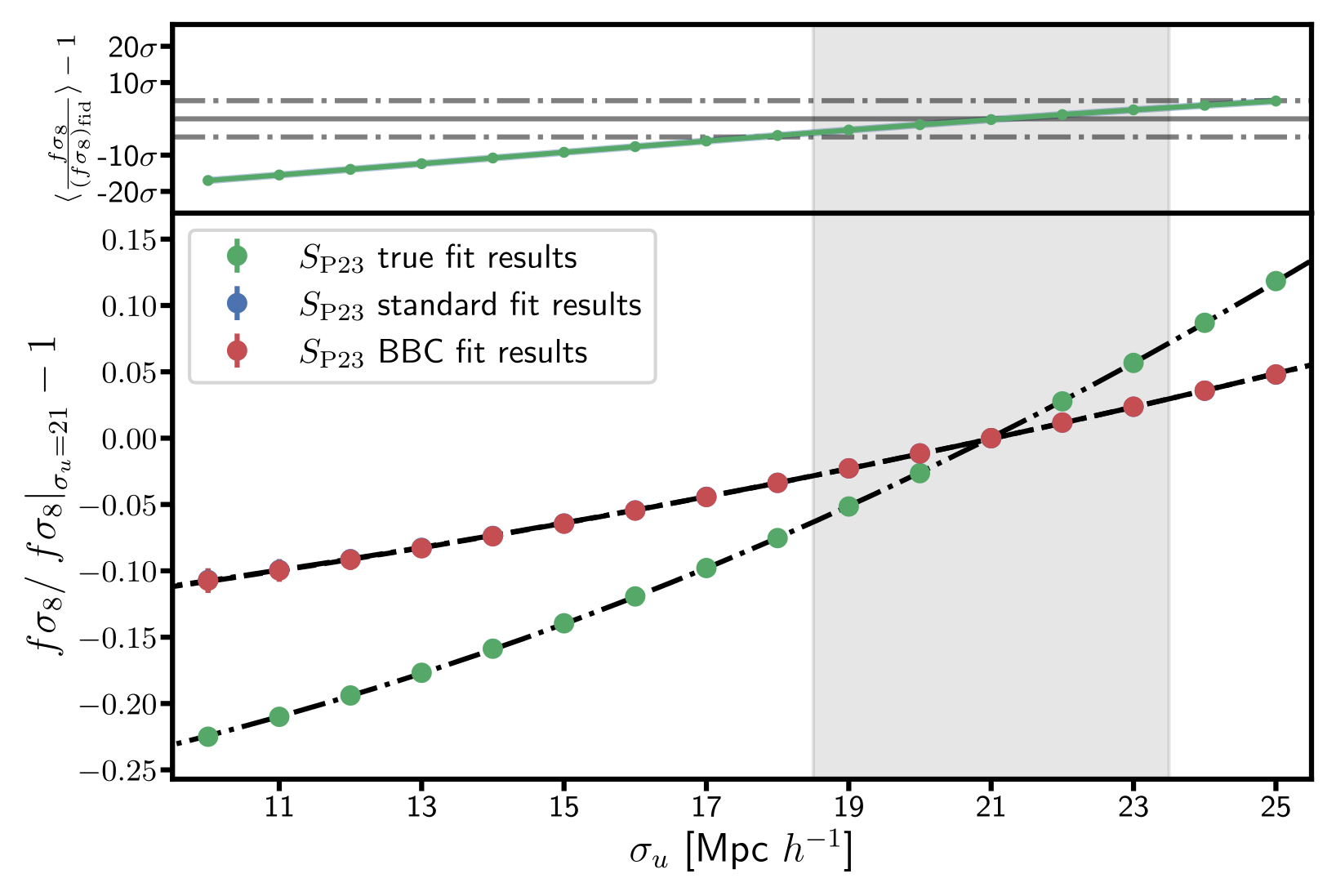
HD residuals
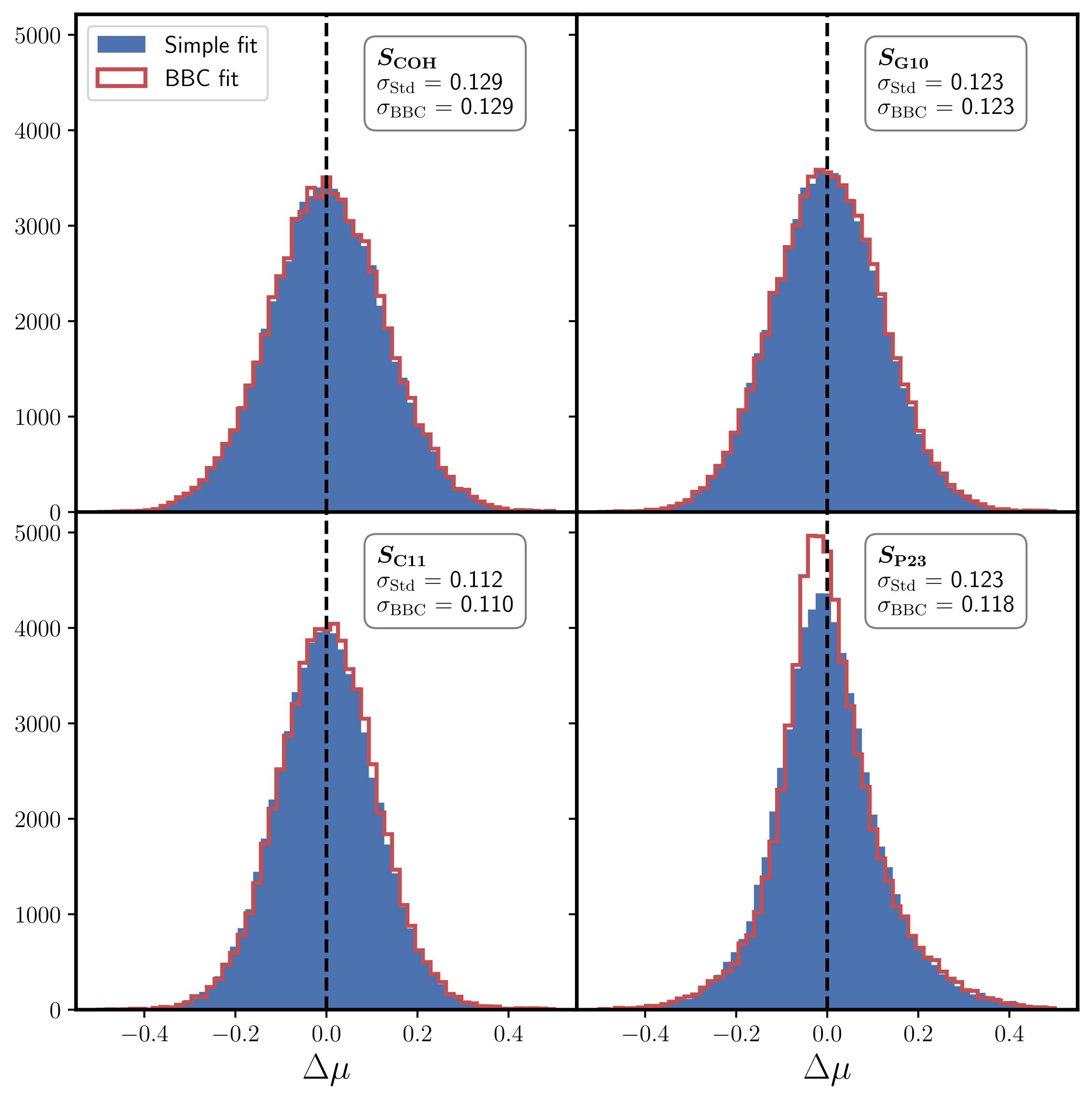

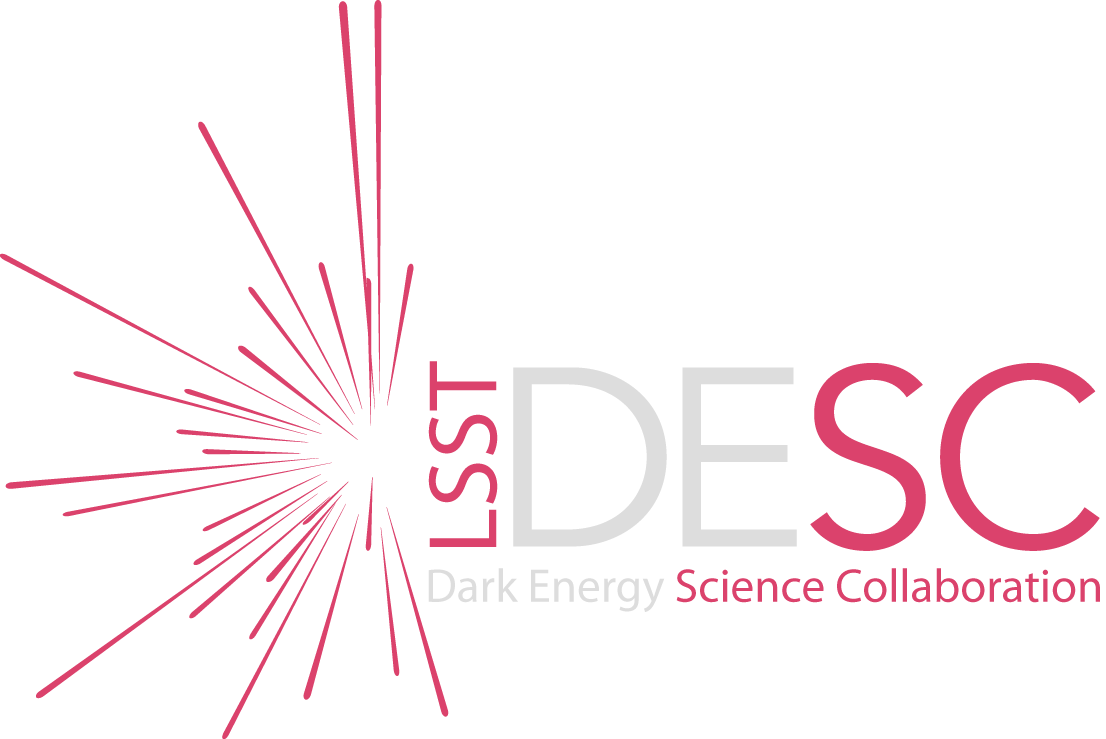
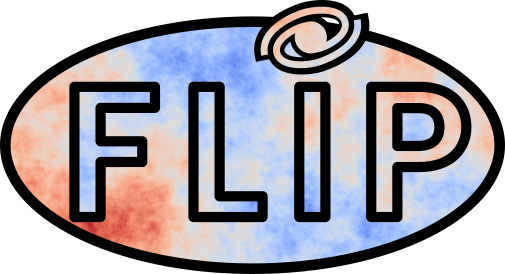 package (Ravoux, Carreres et al. 2025)
package (Ravoux, Carreres et al. 2025)